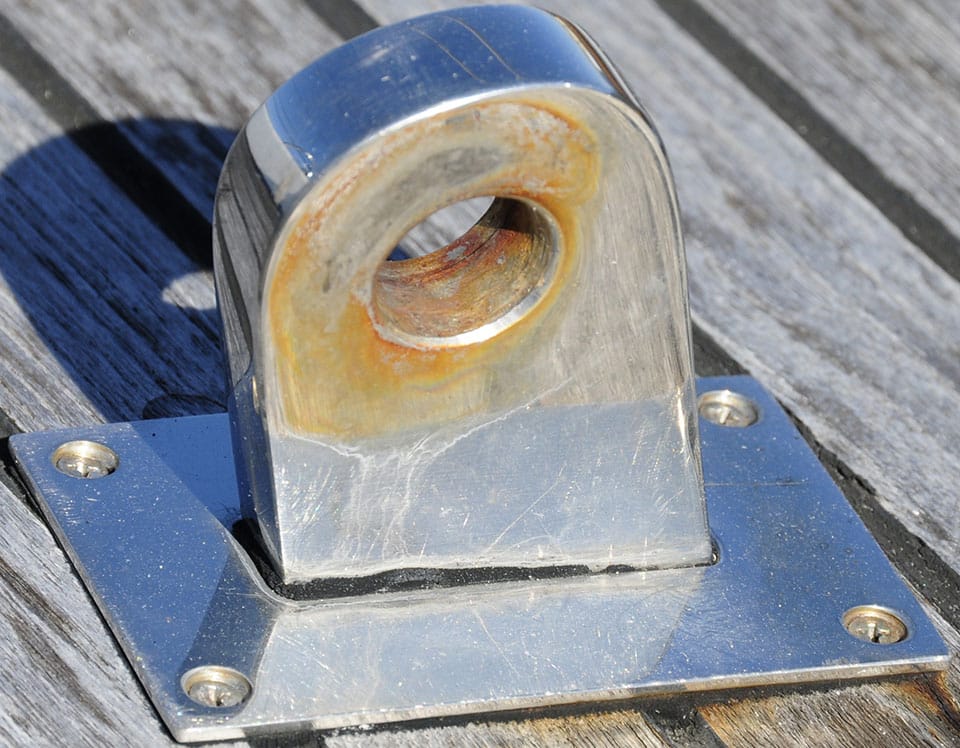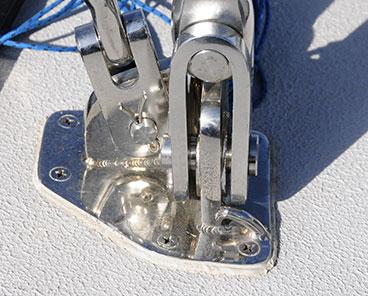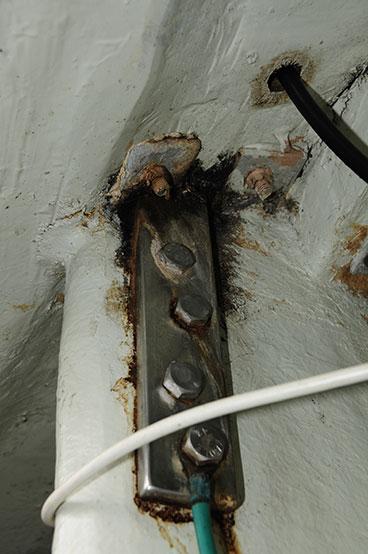
Chain Plate
Here’s the problem with chainplates: These vital components are often buried in the deck, hull, or behind joiner work where they can’t be easily seen. So how do you know when they need to be serviced? Luckily, telltale signs indicate when they require a refit.
Most chainplates installed on fiberglass boats are made of stainless steel. While it’s tough and durable, in order for stainless steel to remain corrosion-resistant, it must have access to oxygen; that’s where the trouble often begins. Most chainplates pass through a deck, where they’re fastened to the hull or a frame. Ideally, in new installations, the area where the chainplate makes its transit through the deck is kept dry with bedding.

| |While integral chainplate flanges promote watertight seals, the surface on which they’re installed should be smooth, not non-skid.|
But as the chainplate flexes and the bedding ages, a gap often forms, allowing water to enter. This can ultimately cause the chainplate to suffer from crevice corrosion or, if it’s not properly sealed, saturation of the deck core. Rust stains that emanate from chainplates or fasteners are cause for concern, warranting the removal and inspection of each. Once removed, chainplates should be thoroughly cleaned and carefully inspected for any signs of cracking, pitting, or other irregularities.
To complicate matters, it’s very difficult to get traditional polyurethane sealants, even venerable 3M 5200, to adhere tenaciously to stainless steel for very long. Some installations are more problematic than others. In many cases, the wax that was used to polish the part when it was originally fabricated contaminates the stainless steel. Wax is a release agent—any trace of it will virtually guarantee non-adhesion. Therefore, before installation, chainplates and stainless-steel deck hardware must be dewaxed using a solvent. (Horizontal compression plates are less prone to sealant failure, leakage, and corrosion because these plates compress the sealant, which acts like a gasket and mostly protects everything from the elements.)
Additionally, polished stainless steel is extremely smooth, which further inhibits the sealant’s ability to forge a mechanical grip. However,

| |The rust on this stainless-steel chainplate is troubling. Inspect where it passes through the deck, then rebed it.|
you can give it a fighting chance to adhere to chainplates by dewaxing the metal, then giving it some “tooth” by sanding it with 220-grit emery cloth. Afterward, clean the chainplate and the surrounding deck bedding surface with solvent, then liberally apply bedding material. For numerous reasons, I’m not a member of the “let it cure before tightening the fasteners” school of thought. Instead, torque it down tightly from the start, then clean the excess material out or let it cure and trim it later.
For bedding deck hardware, I prefer polysulfide over polyurethane. And while this may sound like heresy to diehard traditionalists, for over a decade I’ve also had very good results using silicone sealant, specifically GE Silpruf, rather than polyurethane, especially with stainless steel. If you do choose to use silicone, be very careful not to get it on surrounding deck areas and especially not on your boat’s brightwork. Silicone is the nemesis of paint and varnish.
Steve D’Antonio offers services for boat owners and boat buyers through his company, Steve D’Antonio Marine Consulting.








